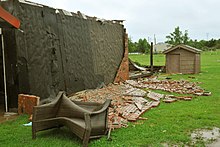|
Masonry veneer
  Masonry veneer walls consist of a single non-structural external layer of masonry, typically made of brick, stone or manufactured stone.[1] Masonry veneer can have an air space behind it and is technically called "anchored veneer". A masonry veneer attached directly to the backing is called "adhered veneer". The innermost element is structural, and may consist of masonry, concrete, timber or metal frame. Because brick itself isn't waterproof, the airspace also functions as a drainage plane, allowing any water that has penetrated the veneer to drain to the bottom of the air space, where it encounters flashing (weatherproofing) and is directed to the outside through weep holes, rather than entering the building. Other advantages of a masonry veneer include:
SupportBecause the masonry veneer is non-structural, it must be tied back to the building structure to prevent movement under wind and earthquake loads. Brick ties are used for this purpose, and may take the form of corrugated metal straps nailed or screwed to the structural framing, or as wire extensions to horizontal joint reinforcement in a fully masonry veneer or cavity wall. Although the veneer is vertically self-supporting, shelf angles are often used in multi-story buildings, typically at floor edges, to provide a horizontal expansion joint that allows expansion of the brick and potential shrinkage of the frame. In multi-story buildings, such a system may be called a curtain wall. Adhered masonry veneer is bonded to the backing so it does not typically need a shelf angle. MaterialsMasonry veneers can be made of brick, concrete, natural stone or manufactured stone product. Typically, masonry refers to individual units that are placed in a mortar bed, making a distinction with panelized products. RainscreensA variant on masonry veneer is the rainscreen veneer. Rainscreens are ventilated at the top and bottom of the cavity to prevent wind-driven rain from being driven into the building by unbalanced pressure. Such systems are typically encountered in areas where blowing rain is a significant concern. Thermal performanceMasonry has high thermal mass, so masonry is slower to heat up, and can continue to release heat long into the night; without insulation half of that heat will be released into the building. Masonry with a dark external surface absorbs more heat than with a lighter external surface, especially if exposed to sunlight. Reverse masonry veneer walls have the brickwork inside and the lightweight frame and cladding outside; this has the advantage of providing the thermal mass on the inside of a building. Masonry itself provides very little insulation, however:
Different configurations of such foil(s), air-space(s), and/or insulating material(s) can perform significantly better at excluding heat during summer and/or retaining heat during winter; these configurations often perform in counter-intuitive ways. Because of the enormous long-term potential for reducing energy requirements and improving occupant comfort, building designers should consult engineers or adopt configurations with known performances. See also
References
|
Portal di Ensiklopedia Dunia